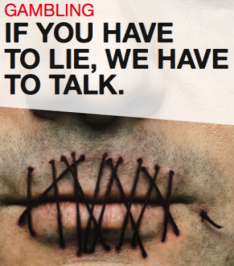Shock advertising: 30 ads that would give Australia’s ad watchdog a coronary
 Is shock an underused weapon in Australian advertising, asks Robin Hicks
Is shock an underused weapon in Australian advertising, asks Robin Hicks
Today, Sydney agency The Cabana Boys used an image of a mouth sewn together to shock people with the idea that problem gamblers lie to conceal their habit. Is it the most disturbing image ever? No. Will it get banned by the Advertising Standards Bureau? No. But it did make me wonder why shock is not used more often in Australia – and not just by charities and government bodies. (WARNING: NSFW)
I spotted a poster ad from Germany yesterday that would cause the good folk at the Advertising Standards Bureau to spit in their green tea. I had a look for others that might have a similar effect, then had a look for Australian examples of advertising designed to shock.
Some of this lot are just plain disturbing. Others are possibly scam. But hey, with Cannes around the corner and awards on the mind, why let boring old accountability get in the way of the gratuitous pursuit of infamy? Besides, like it or not, shock works.


Some fantastic examples there, something to think about on a Monday morning
Wow… Seriously disturbing but extremely effective. I am a little bit shellshocked by some of these, which is exactly what good advertising should do.
So sex, kids and body mutilation is the go? Got it. Not.
Clever, shocking, in-your-face. Not sure I would want my kids to view many of these ads, but as the visionary George Lois – one of the original ‘Mad Men” – once famously said: “advertising should be like poison gas. It should grip you by the throat, it should bowl you over.” On that basis, George would no doubt have approved of most of these communication platforms!
The Gambling ‘if you have to lie, we have to talk’ campaign has some similarities to the US Declare Yourself campaign featuring a number of celebrities with their mouths stitched. This campaign aimed to encourage young people to have a voice and vote in the 2008 Presidential elections. There’s some stunning and powerful images, particularly Christina Aguilera and Jessica Alba – Google them to check them out.
The ‘No Anorexia – No-l-ita’ ad you include was particularly shocking because it was of a real model, Isabelle Caro…and after the campaign she died of anorexia…making it even more powerful: http://www.nytimes.com/2010/12.....1caro.html
I want to work in-house at Tom Ford.
Would someone be able to explain to me what “scam” is that keeps getting referred to in relation to research in this article? Is it as simple as not doing the research or is something more…?
@James – a scam ad is one created purely to try and win awards, so work that isn’t actually published, approved by the client or used -but this isn’t disclosed by the agency.
Sometimes even work created for a client whose account belongs to another agency.
As a client we had done a campaign in radio and tele and press online – all the usual and the creative agency wanted to enter a longer version of the radio ad for Canne.
But it needed to be a real ad and to be real it had to run. They asked us if we could include it in our media schedule which i nixed as its not our job to pay for ads for the agency to win awards, but being a very large advertiser we asked the media agency to work something out with a radio station for the creative agency so they could run the ad once to qualify for Canne.
A radio station came to the party and agreed to run it at 1:30am in the morning once and voila, a ‘genuine’ non-scam entry for Canne
I would argue that good advertising should resort to entertaining people into what the message is. The moment a brand starts putting prices into their ads, I know that they’re in a hurting industry. I remember the days when very few car ads would tote the price of the vehicle, and now they almost all do.
Health insurance is traditionally about “feeling better (now)”, pardon the pub, yet in the last 2 years, all I’ve seen is price-driven advertising, and found it a breath of fresh air seeing Medibank and Bupa go for product oriented advertising,, again. It’s been too long.
It’s something that Coca-Cola and Cadbury have never lowered themselves to, going for price jaunts. Yes, holidays and the like are in there too, but not “get a coke for $x” which, to my mind, hasn’t happened since the 1920s in the height of the great depression and despite the mixed financial crises around the world right now, it’s only the frontline retailers who are actually fighting on price about the Cadbury or Coca-Cola prices.